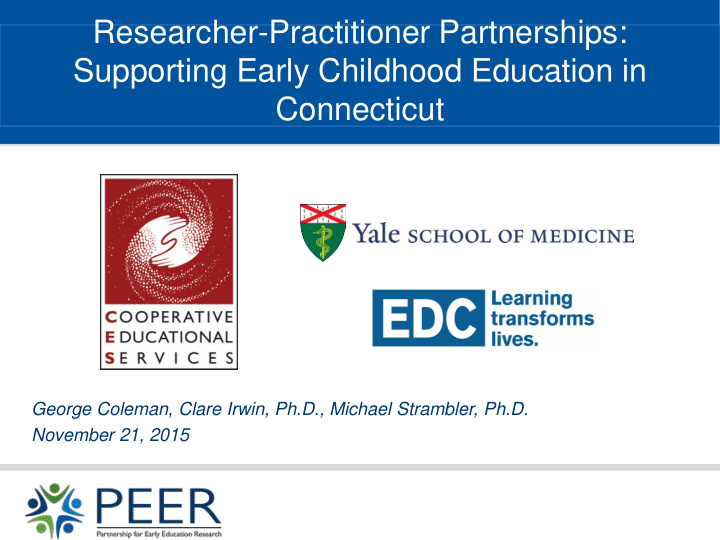



Researcher-Practitioner Partnerships: Supporting Early Childhood Education in Connecticut George Coleman, Clare Irwin, Ph.D., Michael Strambler, Ph.D. November 21, 2015 S L I D E 0
Objectives • Provide an overview of researcher-practitioner partnerships and their benefits • Discuss regional resources related to researcher- practitioner partnerships • Highlight the work of a Connecticut researcher- practitioner partnership and how participants can become involved in this work S L I D E 1
What is C.E.S.? • Cooperative Educational Services, one of CT’s six Regional Educational Service Centers (RESCs) S L I D E 2
About C.E.S. • Mission: To identify and provide quality educational opportunities for educators, students, families, and communities in coastal Fairfield County, Connecticut. S L I D E 3
C.E.S. Early Childhood Education Goals 1. Develop a model in-house School Readiness program as part of a regional ECE professional development and technical assistance services to schools, programs and families. 2. Establish a program of scientifically informed preschool professional development that is accessible to providers in the region. 3. Engage higher education and regional teacher preparation programs in developing professionals prepared to educate children and students who generally enter the public educational system behind their statewide age cohort. S L I D E 4
C.E.S.’s interest in Collaborative Research • Collaborative research can: – Give public educational systems better scientific knowledge that allows them to affect systems accountability and goal-oriented learning for young children. – Increase public investment in and expectations for substantial growth and reduced initial learning disparities. – Provide the tools to produce early educational gains that can be sustained throughout the public school experience. S L I D E 5
What is a Regional Educational Laboratory? • Network of 10 RELs across the country • Help states and districts use research and data to inform policy and practice with the goal of improving student outcomes • Funded by USED Institute of Education Sciences ies.ed.gov/ncee/edlabs/ Regional Educational 6 Laboratory at EDC relnei.org
REL Northeast & Islands (REL-NEI) States and Territories • Connecticut • Maine • Massachusetts • New Hampshire • New York • Puerto Rico • Rhode Island • US Virgin Islands • Vermont Regional Educational 7 Laboratory at EDC relnei.org
REL-NEI Outreach: 2014 Year-End Statistics Regional Educational 8 Laboratory at EDC relnei.org
What is a REL-NEI Research Alliance? Regional Educational 9 Laboratory at EDC relnei.org
REL-NEI Research Alliances Each alliance addresses one or more regional priorities: • Early Childhood Education Research Alliance • English Language Learners Alliance • Northeast College and Career Readiness Research Alliance • Northeast Educator Effectiveness Research Alliance • Northeast Rural Districts Research Alliance • Puerto Rico Research Alliance for Dropout Prevention • Urban School Improvement Alliance • US Virgin Islands College and Career Readiness Research Alliance Regional Educational 10 Laboratory at EDC relnei.org
REL-NEI Resources • Publications • Bridge Events • Skill-Builder Webinars • Online Professional Development • Reference Desk • Blogs and Newsletters http://www.relnei.org/ Regional Educational 11 Laboratory at EDC relnei.org
Origin of PEER + + = S L I D E 12
What is PEER? • Alliance among early childhood stakeholders in Bridgeport, Norwalk, and Stamford – Classroom-level practitioners – Administrators – Child advocates – Policymakers – Researchers • Funded in 2014 by U.S. Department of Education, Institute of Education Sciences S L I D E 13
Alignment among Management Team Members • Shared emphasis on practitioner -oriented research that can drive policy and practice • C.E.S. and PEER serve the same three priority school districts • Roles of core partners: – C.E.S. serves as convener/liaison – Yale contributes research expertise – EDC contributes collaborative research expertise S L I D E 14
PEER Organizational Structure S L I D E 15
PEER Goals Conduct and use high Build infrastructure Collaboratively quality research to for conducting develop a research guide practice and collaborative research agenda policy S L I D E 16
PEER Capacity Building Progress • Engaged with potential partners • Developed communication structures • Held two agenda-setting workshops with stakeholders • Applied for research grant involving PEER partners • Developing data sharing agreements • Planning to fund research agenda S L I D E 17
Potential Research Topics S L I D E 18
Potential Types of Research • Review of scientific literature on best practices • Examining links between practices and outcomes • Examining effects of policies • Exploring predictors of student success/failure S L I D E 19
What’s Next for PEER • Finalize research agenda • Administer early childhood educator survey on assessment practices • Organize early childhood conference (Spring 2016) • Secure funding for pursuing research agenda S L I D E 20
Benefits of Local Partnerships Like PEER • Bridge the gap between researchers and practitioners • Use resources more efficiently • Make data more relevant and useable • Give research a key role in guiding practice and improving outcomes for children • Example: Consortium on Chicago School Research S L I D E 21
How can you get involved? • Advocate for research partnerships in your district and in Connecticut • Support data-sharing with research partners • Suggest ideas for possible funders S L I D E 22
Thank you! Learn more about PEER at http://peer.yale.edu S L I D E 23
Recommend
More recommend